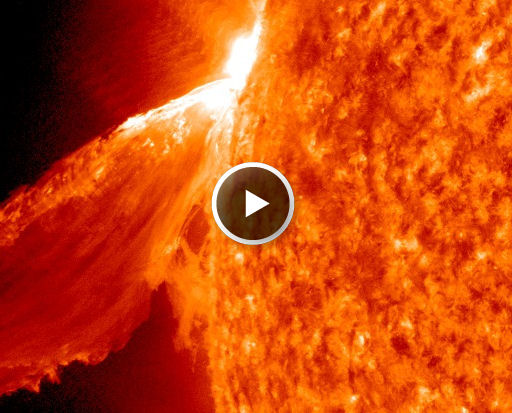Metallic photos of the sun by renowned photographer Greg Piepol bring together the best of art and science. Buy one or a whole set. They make a stellar gift. | | |
LAST FLIGHT OF DISCOVERY: The final voyage of space shuttle Discovery is underway. The orbiter lifted off at 4:53 p.m. EST Thursday from NASA’s Kennedy Space Center on a 12-day mission to deliver Robonaut 2 and supplies to the International Space Station. Discovery is currently chasing the ISS around Earth, and it may be possible to see them both as they converge in the night sky. Check the Simple Satellite Tracker for flyby times.
launch images: from Pete Lardizabal at the Canaveral National Seashore Park, FL; from Mike Theiss at the Kennedy Space Center
EARTH DODGES A BULLET: New sunspot 1163 doesn't look very impressive, but the M3-class flare it unleashed yesterday was absolutely spectacular. Click to play a movie recorded by NASA's Solar Dynamics Observatory:

When the eruption occurred, sunspot 1163 was behind the sun's eastern limb. Nevertheless, enough ultraviolet radiation spilled over to create waves of ionization in Earth's upper atmosphere. Low-frequency radio signals, which bounce off of ionized air, were strongly disturbed, as shown in this plot from a VLF monitoring station in Slovakia. Otherwise, Earth was little affected. Plasma clouds produced by the blast did not come our way.
Sunspot 1163 will continue turning toward Earth in the days ahead, setting the stage for more potent geo-effects if the eruptions continue. Stay tuned.
SOLAR SAIL FLARE: Last night (Feb. 23), NanoSail-D sailed over Seinäjoki, Finland, and when it did, the spacecraft's reflective fabric caught a sunbeam and flared. "I've never seen anything like it," says Juha Peräsaari who recorded the event using a Canon 400D digital camera:

Photo details: Canon EOS 400D, 20mm lens, f2.8, ISO100, 10s exposure. [more]
"NanoSail-D 'flashed' just as it passed the star Procyon," he says. "For a moment, the sail was the brighter of the two." This means NanoSail-D can flare at least to magnitude +0.3 (the brightness of Procyon), or almost twice as bright as a first magnitude star.
Even brighter flares could be in the offing. The orbit of NanoSail-D is decaying as it skims the top of Earth's atmosphere. Sunglints from the descending sail could intensify to Venus-brightness and beyond. Anyone who photographs such an event could win $500.
NanoSail-D Photo Gallery
[NASA: Solar Sail Stunner] [Photo Contest]
February 2011 Aurora Photo Gallery
[previous Februaries: 2010, 2009, 2008, 2007, 2006, 2004, 2003, 2002]

